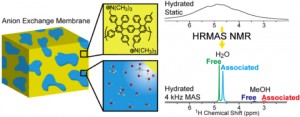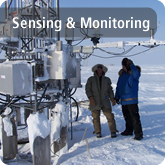Sandia researchers have developed new high-resolution magic angle spinning (HRMAS) nuclear magnetic resonance (NMR) spectroscopy techniques to investigate diffusion in polymer membranes. By coupling HRMAS NMR with pulsed field gradient (PFG) diffusion techniques, the team has demonstrated the unprecedented resolution of individual chemical species within a series of fuel cell anion exchange membranes (AEMs). The team is composed of Janelle Jenkins and Todd Alam (both in Electro, Optical, and Nanostructures Department) who developed and implemented the NMR techniques and Michael Hibbs (Materials, Devices, and Energy Technologies Department) who synthesized the different AEMs.

High-resolution magic angle spinning (HRMAS) 1H NMR in combination with 2-D exchange NOESY and pulsed field gradient (PFG) NMR diffusion experiments have been used to characterize 1N methanol swollen polymer anion exchange membranes (AEMs) presently being developed for alkaline fuel cells.
“Many researchers have assumed a single solvent environment for swollen fuel cell polymer membranes. There have been a few groups that make hand waving arguments for the presence of different water environments, but are unable to provide direct experimental verification. The HRMAS PFG NMR experiments developed in this lab are able to immediately resolve multiple water and methanol environments within the membranes, and then directly measure the diffusion rates for each of these individual chemical species. There are simply no other experimental techniques that can provide this level of chemical resolution and measure of transport properties for the different environments within polymer membranes,” said Alam of the NMR research group.
These results are expected to provide improved experimental baseline for understanding and simulations involving complex solvent transport within polymer membranes. This work was funded by LDRD and was recently published in ACS Macroletters. The HRMAS technique has also been extended to swollen polymers and ionic liquids at surfaces, as recently described in a review by Alam and Jenkins in “HRMAS NMR Spectroscopy in Materials Science” in Advanced Aspects of Spectroscopy INTECH (2012, chapter 10).
Read the abstract in ACS Macroletters.
 ECIS Highlights
ECIS Highlights













 RSS
RSS Google+
Google+ Twitter
Twitter Facebook
Facebook LinkedIn
LinkedIn YouTube
YouTube Flickr
Flickr